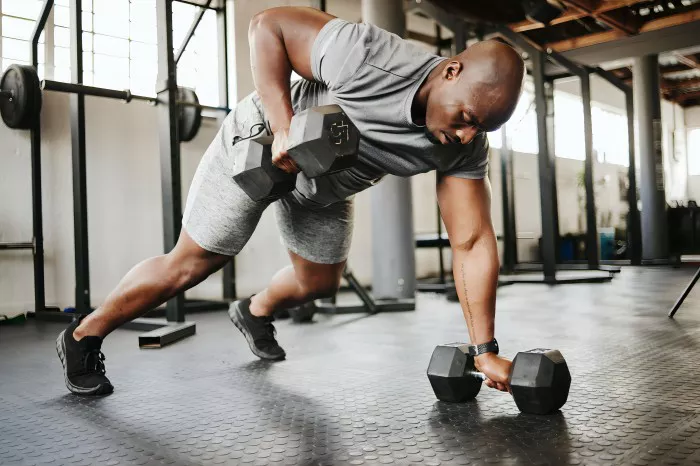Lifting dumbbells correctly is crucial for maximizing your workout benefits and preventing injuries. This article will cover everything you need to know about lifting dumbbells correctly, from basic techniques to advanced tips. Let’s dive in.
Introduction to Dumbbell Training
Dumbbells are versatile pieces of equipment that can enhance your strength training routine. They allow for a wide range of exercises targeting different muscle groups. Whether you’re a beginner or an experienced lifter, proper form and technique are essential.
Benefits of Dumbbell Training
Versatility
Dumbbells can be used for various exercises, from bicep curls to squats, making them a versatile addition to any workout routine.
Muscle Imbalance Correction
Using dumbbells helps correct muscle imbalances by allowing each side of your body to work independently.
Improved Range of Motion
Dumbbells allow for a greater range of motion compared to machines, leading to better muscle engagement and growth.
Convenience
Dumbbells are compact and easy to store, making them ideal for home workouts.
How to Lift Dumbbells Correctly
Warm-Up
Before lifting dumbbells, it’s essential to warm up your muscles. A proper warm-up increases blood flow to your muscles, reduces the risk of injury, and enhances performance.
Dynamic Stretching
Perform dynamic stretches such as arm circles, leg swings, and torso twists to get your muscles ready for action.
Light Cardio
Engage in 5-10 minutes of light cardio, like jogging or jumping jacks, to elevate your heart rate and loosen up your body.
Proper Form and Technique
Grip
Hold the dumbbells with a firm yet comfortable grip. Your palms should face your body or each other, depending on the exercise.
Stance
Maintain a stable stance with your feet shoulder-width apart. This stance provides a solid base for lifting and helps maintain balance.
Posture
Keep your back straight, chest up, and shoulders back. Good posture ensures proper alignment and reduces the risk of injury.
Breathing
Breathe in through your nose before lifting and exhale through your mouth during the lift. Proper breathing helps stabilize your core and enhances performance.
Controlled Movements
Lift and lower the dumbbells in a controlled manner. Avoid using momentum or swinging the weights, as this can lead to poor form and potential injuries.
Range of Motion
Use a full range of motion for each exercise. This ensures maximum muscle engagement and better results.
Common Dumbbell Exercises and How to Perform Them
Bicep Curls
Stand with your feet shoulder-width apart and hold a dumbbell in each hand.
Keep your elbows close to your torso and your palms facing forward.
Curl the dumbbells up towards your shoulders, contracting your biceps.
Lower the dumbbells back to the starting position in a controlled manner.
Shoulder Press
Stand or sit with your feet shoulder-width apart and hold a dumbbell in each hand.
Raise the dumbbells to shoulder height with your palms facing forward.
Press the dumbbells overhead until your arms are fully extended.
Lower the dumbbells back to shoulder height in a controlled manner.
Dumbbell Squats
Stand with your feet shoulder-width apart and hold a dumbbell in each hand at your sides.
Lower your body into a squat position by bending your knees and hips.
Keep your chest up and back straight throughout the movement.
Push through your heels to return to the starting position.
Dumbbell Rows
Stand with your feet shoulder-width apart and hold a dumbbell in each hand.
Bend your knees slightly and hinge at the hips, keeping your back straight.
Pull the dumbbells towards your torso, squeezing your shoulder blades together.
Lower the dumbbells back to the starting position in a controlled manner.
Dumbbell Bench Press
Lie on a flat bench with your feet flat on the floor and hold a dumbbell in each hand.
Press the dumbbells up until your arms are fully extended.
Lower the dumbbells back to chest level in a controlled manner.
Repeat the movement for the desired number of repetitions.
Advanced Dumbbell Techniques
Supersets
Perform two exercises back-to-back without rest. This technique increases workout intensity and efficiency.
Drop Sets
Perform an exercise to failure, then immediately reduce the weight and continue the set. This technique helps build muscle endurance and size.
Pyramid Sets
Increase the weight with each set while decreasing the number of repetitions. This technique enhances strength and muscle growth.
Negatives
Focus on the eccentric (lowering) phase of the exercise. This technique increases muscle tension and growth.
See Also: What Is The Easiest Way To Lose Weight Without Exercise
Tips for Effective Dumbbell Workouts
Consistency
Stick to a regular workout routine to see the best results. Aim for at least 3-4 sessions per week.
Progressive Overload
Gradually increase the weight and intensity of your workouts to continue making progress.
Proper Nutrition
Fuel your body with a balanced diet rich in protein, carbohydrates, and healthy fats to support muscle growth and recovery.
Hydration
Stay hydrated before, during, and after your workouts to maintain performance and recovery.
Rest and Recovery
Allow your muscles to recover by incorporating rest days into your routine. Adequate sleep is also crucial for recovery and growth.
Common Mistakes to Avoid
Using Too Much Weight
Lifting too much weight can compromise your form and increase the risk of injury. Start with a weight you can handle comfortably and gradually increase it.
Poor Form
Using improper form can lead to injuries and reduce the effectiveness of your workouts. Focus on maintaining proper posture and technique.
Skipping Warm-Up and Cool-Down
Neglecting to warm up and cool down can lead to muscle strains and other injuries. Always include these components in your workout routine.
Overtraining
Training too frequently without adequate rest can lead to burnout and injuries. Listen to your body and give it time to recover.
Conclusion
Lifting dumbbells correctly is essential for achieving your fitness goals and preventing injuries. By following the guidelines and tips outlined in this article, you can enhance your dumbbell training routine and enjoy the many benefits it offers. Remember to stay consistent, focus on proper form, and prioritize recovery for the best results. Happy lifting!


